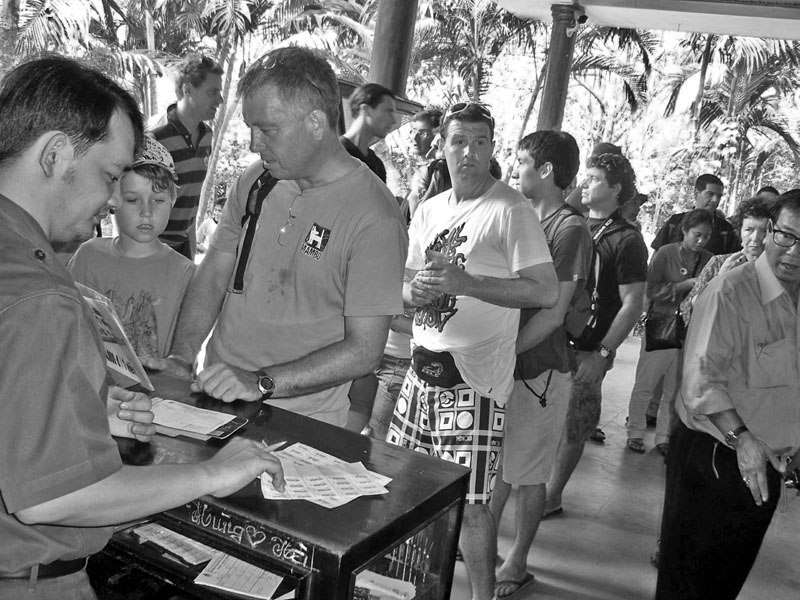
National Historical Institute chair Ambeth Ocampo, National Museum director Cora Alvina and chef Aleth Ocampo in Cha Ca La Vong, Hanoi, December 25, 2009

Tourists queue to fire assault rifles after a tour of the Cu Chi Tunnels.
On Christmas Day, I bumped into historian Ambeth Ocampo with his large family and National Museum director Cora Alvina in Hanoi, in a ramshackle, rickety restaurant called Cha Ca La Vong. The main dining area is on the second story, on a floor of wood boards that shakes from mere footfall. A massive altar is suspended on one wall; it heaves with brass urns choked with burnt out incense sticks. The green walls are so sooted over, the effect looks almost deliberate.
In most other instances, the setting would turn away people. But this is Cha Ca La Vong, 105 years old. Very few restaurants in the world survive to this age. Certainly, none of them survived on a single dish, as Cha Ca La Vong has.
There's only one item on the menu: fish. First bowls of fresh herbs and cold rice noodles are brought to you, then sizzling in a skillet over a live fire on paraffin bricks, collops of white fish in oil made yellow by turmeric. Into the skillet, you toss at will fresh chopped scallion and dill. When cooked enough for you, spoon the fried fish and veg onto white noodles, eat with fresh herbs and peanuts. Scrumptious.
For some of us, Cha Ca La Vong is one of the world's best restaurants, in that elite list of those worth traveling to find. Tragically, it seems many don't get it and think of it as a place that was built to trap their money.
"Total rip off," cries kimjennifer of the USA in a member review on the Lonely Planet's entry on the restaurant online. "Tourist rip off!!!" concurs singalingaling of Singapore, both of whom were in parties they say were charged VND (Vietnamese dong) 100,000 or over US$5, an exorbitant amount by Vietnamese standards.
As soon as you sit down, a member of the famously surly staff hands you a laminated strip of paper expressly declaring "We only serve one dish" at VND40,000 or a little over US$2.
"The place was awful," rues singaling. "And just imagine the carbon monoxide released from the tables with burning charcoal." "A fire trap!!" echoes wizemen2, who titles his entry "It's rubbish". Paying VND100,000 for food scraps worth maybe VND500 is to me a restaurant making hay while the sun shines," elaborates the latter. "Only twice the amount asked at this establishment for a feed of scraps will get you a fine buffet at a five-star hotel, with a range of over 100 different dishes, so how does that make sense?"
What doesn't make sense to me, however, is why wizemen2, singalingaling or kimjennifer should at all venture out of the five-star hotel where a celestial plenitude of food from all corners of the globe comprise the greatest value for tourist dollars. Indeed, why leave the first world at all?
For many travelers from the first world, the planet is kind of like Universal Studios, a series of vacated sets from some dramatic old story. It isn't really very moving as such—just a bunch of rubble or overgrown trees—but it's important for one's social standing to be able to say that one has been there. It's just really annoying when the service is bad, the staff doesn't understand you, it's hot and there are unexterminated bugs about.
Born only in 1975, Ho Chih Minh City recounts the violence that brought it into being in the War Remnants Museum, a restrained, fair and heart-breaking depiction of an unspeakably cruel and dishonorable war in photographs with brief captions. Just outside the city are the Cu Chi tunnels, the 121 km underground network that helped the Viet Cong defeat the Americans. The tunnels are a major tourist destination today. Bus loads arrive constantly and the hordes are led with great organization through various destinations along the network. The tour is factual, it does not belabor or proselytize.
It can be unnerving, however, because throughout you can hear nearby gunfire. At the end of the tour, you can buy a cartridge of M-16 bullets to fire in a shooting range with the drawing of a rabbit on paper as a target. Those bullets are frightening. They're huge and pointed, and it's easy to imagine them ploughing into live flesh.
"They should make the target an American," I said loudly. How some people glared. Surely by replacing the rabbit with a drawing of an American the history of the place would have been more frankly told, the lessons of history more viscerally reiterated. As it is, the white men gleefully make a beeline for the guns with their sons. "I shot the rednecks," I said again loudly after having photographed the line.
After the tour, the buses—all brand new and gleaming—like a Universal Studios caravan, wend their way to a nearby restaurant, a tile-roofed open-air structure in traditional archiecture in the middle of fish ponds. Many of the busloads go there just for a place to sit; lunch is brought to them in large styrofoam boxes containing oranges and apples, chips and deli sandwiches, while the rest of us enjoyed the restaurant's cuisine which included freshly caught fish from the surrounding ponds.
Lost in Translation, the title of this entry of The Philippine Spectator, comes from the name of a terrible film by Sofia Coppola, the daughter of Francis Ford Coppola, who once made a film about the Vietnam war in the Philippines. In Lost the protagonist Bill Murray mopes for days at the Grand Hyatt in Tokyo, unable to make sense of the natives, who all appear ludicrous, like bugs chattering senselessly.

